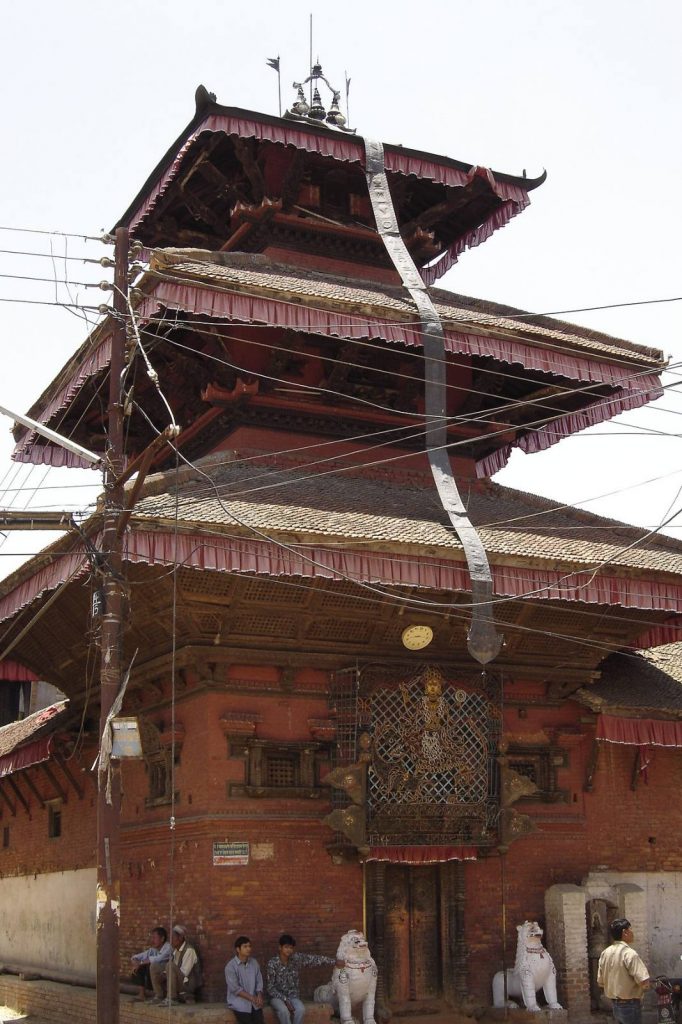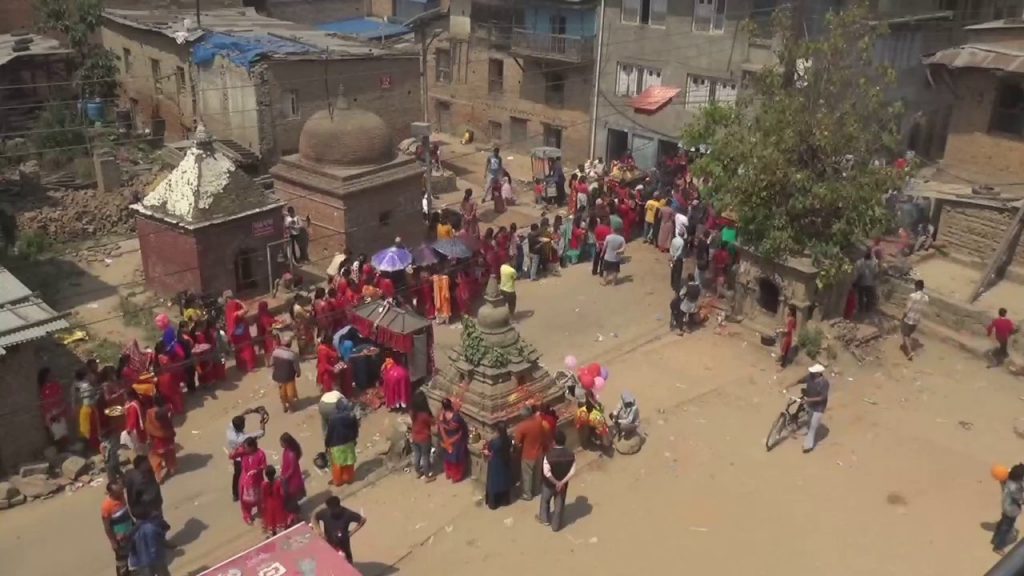Lubhu is the beautiful Newari town with many historical, traditional and cultural significance. The town is the part of the Mahalaxmi Municipality which is the home of the many deities. The settlement in the 730 acres of land of Lubhu is mostly populated by an ethnic Newari community of mainly Shresthas, Maharjans, Rathala and Gobhaju in the main town area and Brahmin and Chhetri in the outskirts area. It lies at the southeast of the Patan along a rough road which passes many brick making factories with the small chimneys.
The town has the typical Newari feeling with the house made up of wood and brick and the people speaking in the native Newari language. Many of the beautiful and fascinating temples are scattered throughout the region and are rarely visited by outsiders. The town has its own cultural and religious aspect with long run history. Lubhu is also known as the place with the golden plate. The town has a total population of about 10374 and the most of the ethnicity are Newars. It is also known by the another name Subarna Chhatrapur but most of the people know this place by the name Lubhu.
Lubhu is the town which is the part of the Mahalaxmi Municipality of the Patan District in Bagmati Pradesh of central Nepal. It is the sub urban Newar place situated about 7 kilometres east of the Kathmandu valley in the northern part of Lalitpur. The town still retains a rural feel, with grain scattered across the road during harvest times. The many family- run weaving yarn mills throughout the town, found often inside the dark and small old houses. Cycling through small towns of the Lubhu gives you a chance to take in the culture, tradition, religion and heritage of this area. Friendly villagers live much as they have for many centuries.
The town of Lubhu is surrounded by the beautiful and interesting folktales of how this place was discovered and got this beautiful name. It is believed that there was a homosexual living in this town. He wanted to become a fully grown man so he worshiped Mahalaxmi and Gobhrateshwar Mahadev to resolve his confused sexual identification. After he worshipped continuously for three years to the Gods, the Gods were finally happy and granted him the body of the complete and refined man. The man was happy that he offered both the deities the plate made up of gold and hence the place was known as Lubhu meaning the plates of gold in Newari.
In old days, the town was hit by the endemic, then ruler of the Town Ganga Maharani was very much worried by this situation. So, she sold her golden plate to save the town from the disease and resettles the city. The queen installed a pandal with a golden roof for the treatment of sick people. It is also believed that God Bhairav laid under a golden umbrella to save the people from the disease. The place was then called ”Subarna Chhatrapur” but was called ”Lubhu” which means the same meaning in Newari language.
The Lubhu is known for its unique and diverse traditional and cultural practices. It is the home of the many deities and long run rituals and traditions. The people here have their own unique jatras and festivals, the most famous being the Maha Laxmi- Maha Bhairav Jatra.
Maha laxmi Temple is the holy and sacred place of the town with significant religious and cultural value. The temple is built in the pagoda style with the pinnacle on the top. The main deity of the temple is the Goddess Laxmi, known as the goddess of wealth. It is the three storied temple with the two lions guarding the main god of the shrine. The temple is mostly crowded during the main jatra of the town and special occasions like Vijaya Dashami and Laxmi Puja of the Tihar. The two chariots inside the temple of Maha Laxmi are located with the golden plated masks of deities that are housed in the same.


Govrateshwor Mahadev temple is another famous cultural heritage of the town which has been inscribed in Skanda Purana . This temple has a great history associated with Kamdhenu Cow, Pashupati and Shringa Rishi. The main shrine of the temple contains the Lingam of the Lord Shiva which is one of the 64 Lingas of the Lord Shiva.


According to the purana, Under the Hills of Chakranemi) there is a temple of Govrateswor Mahadev where Birupaxa had visited and worshiped Mahadev with Nemuni. Nepal has been named with the great contribution of the same sage or rishi Nemuni. The Birupaxya Brahman had taken holy baths on Shringa Tirtha) and Gomati (River from Ghimire Gaun) Rivers at Lamatar of Ramtar Ram Mandir) had worshiped the Govrateswor on Chaitra Shukla Dwadashi. Birupaxya and Nemuni stayed the night and Nemuni had told the story to Birupakshya. Many years back Shringa Rishi had taken the holy bath and saw the Kamdhenu returning to the Charanawat Cave (A cave in Bhimsen Danda) all of a sudden, she produced dong. Shringi Rishi held that dong and established a Shiva Linga. As it was developed from dong it is called Govrateswor.
The temple is built in a pagoda style with the pinnacle on the top. It has four doors around the main shrine. The temple is mostly crowded during the Mondays of month Shrawan according to the Nepali Calendar and auspicious day of the Teej.
People of the Lubhu have their own distinct culture and tradition. They have their own festivals and jatras . Their main and famous jatra is Maha Laxmi- Maha Bhairav Jatra observed in the month of the Baisakh according to the Nepali Calendar. This is the time of the year when the whole community of the Lubhu get out of their monotones to celebrate in a truly carefree fashion. The two chariots inside the temple of Maha Laxmi are loaded with the gold plated masks of deities.
While one of the chariots is used to carry a set of Maha Laxmi, Ganesh and Kumar idols and the other chariot is used to carry another set of Maha Bhairav, Ganesh and Kumar. The chariot is carried by the drunken revelers to make a complete tour of all the houses in the locality. Bringing the Maha Laxmi closer to your home is believed to bring you auspices of peace and prosperity.


The Khat Jatra starts on Akshaya Tritiya along with the Rato Machindranath Jatra. It is observed on Panchami. The weeklong festival is celebrated with feat and entertainment in the company of friends, family and relatives. It is believed that Ganga Maharani in 650 Nepal Sambat started the jatra. According to cultural experts, one out of four wheels of the Chariot of Rato Machindranath is regarded as the representative of the Bhairav of Lubhu. There is another temple further up the location of the main MahaLaxmi Temple that houses the mother of Goddess Maha Laxmi. That temple is known as Devisthan. During this jatra, the statuette of the same chariot is taken to her mother’s temple so that the mother- daughter meeting can take place, marking the climax of the carnival.
We can get to this historical and traditional Newari town by the public buses from the bus station of the Kathmandu valley as well as from the Lagankhel.
Shopping is my option in contrast to Red Bull. Regardless…


Hundreds of years of preservation and perseverance, nourished and timely…
Among the many 12 years festivals Nepal has, Lha Phewa…